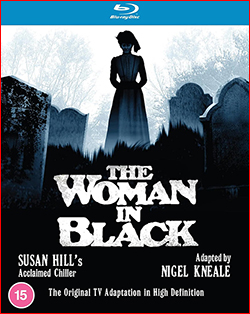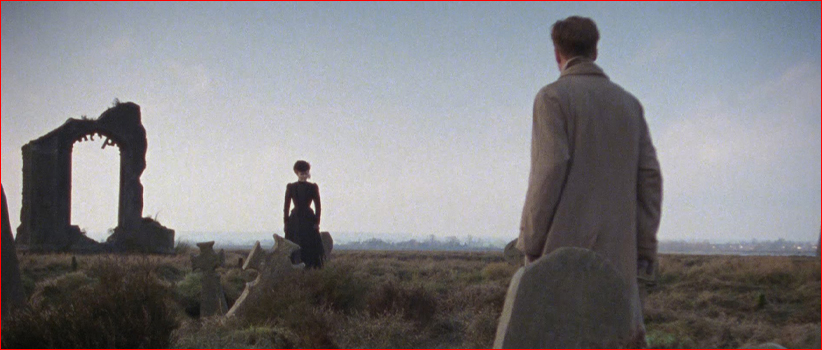 It’s the fine year of 1925 and the place is a chronic depressive England where it’s always gloomy and misty and extra cozy by the fireplace. Arthur Kidd (played by Harry Potter’s dad, Adrian Rawlings) is a young solicitor in his early 30s. He’s married and has two children who he has to kiss goodbye for a while when his boss sends him from London to a small sleepy Greendale’ish coastal town. The first assignment is to attend the funeral of the mysterious upper-class woman Alice Drablow. And she was not the most popular person in town as only three, or so, is taking the last ta-ta before she gets lowered six feet under. RIP. The townsfolk refuse to talk about her as if she was some Voldermort.
It’s the fine year of 1925 and the place is a chronic depressive England where it’s always gloomy and misty and extra cozy by the fireplace. Arthur Kidd (played by Harry Potter’s dad, Adrian Rawlings) is a young solicitor in his early 30s. He’s married and has two children who he has to kiss goodbye for a while when his boss sends him from London to a small sleepy Greendale’ish coastal town. The first assignment is to attend the funeral of the mysterious upper-class woman Alice Drablow. And she was not the most popular person in town as only three, or so, is taking the last ta-ta before she gets lowered six feet under. RIP. The townsfolk refuse to talk about her as if she was some Voldermort.
Now the tedious work starts. And that is to visit Drablow’s gothic mansion, called Eel Marsh House, located by itself on an isle with a tidal causeway, and go through a mountain of papers. The old mansion, overgrown with vines and frozen in time, looks more welcoming than it should, but it doesn’t take long before the bad vibes creep in.
We don’t see much of the woman in black, but we absolutely feel her stone-cold presence, although most of the film happens during the daytime. And it actually works as the surroundings are bleak and ghostly by itself, where it doesn’t matter much if you spot a ghost at night or in broad daylight. That’s England for you.
The woman in black is played by Pauline Moran, who could as well be the sister of Jean Marsh. When we first see her outside the house where she gets the first direct eye contact with Arthur, she eyeballs him right through his sorry soul with sadness and burning radioactive hatred. She has that look as if someone just bent over and gave a big, bubbly, wet bean fart straight at her face. And once you’ve got eye contact with her, you’re, more or less, marked for life and will never be the same again, somewhat similar to a certain cursed Asian VHS tape from the 1990s.
There’s also a family graveyard by the house. Not subtle at all. So, of course, this place is haunted. But there’s work to do. Arthur gets a cute little dog, Spike, to keep him company as he dives more and more into her papers, going through cryptic tape recordings, to finally settle down the Eel Marsh House.

Then the good boy gets worried, runs out and disappears in the thick fog. As Arthur runs after him, he only hears screams coming from everywhere and the sounds of horses galloping. So what’s he gonna do? Take the train back to London and tell his cigar-smoking boss with a straight face that he got spooked away by ghosts? Of course not. And when the work is done it will finally be time to go back home to London, and hopefully forget about that creepy woman in black. But she won’t forget about you. Never. And no, nothing bad happens to the dog, so chill down.
The film is directed by Herbert Wise, based on the novel by Susan Hill. The script is written by Nigel Kneale, one of the most prolific screenwriters in the UK at the time. This is not your typical ghost ride with jump scares, loud music and so on, and certainly not for TikTokers with a half-second attention span. The Woman in Black is a classy ghost story, a tragic one as well, told in the old-fashioned style as the mystery of this Alice Drablow is basically told via letters and eerie tape recordings.
The film is very slow-burn’ish at times where we have some slick and elegant long one-shot takes so we can get a real sense of the place. The mood and the somber, gloomy cold atmosphere are the strongest elements here where with clever use of sound design, especially during the thick fog scenes. I also find it more effective that we see most of the woman in black at a distance where her sickly face is more blurred and obscured, which makes her look way more ghostly and mysterious. Makes me think of the cover of the first Black Sabbath record.
The film is also known for “that scene“ which alone was enough to ruin the whole Christmas for the Brits when it aired on the telly. The scene that really got me though, was the ending. So simple yet so damn chilling. As a low-budget movie made for TV, it surely looks impressive, still after 30-plus years, and the performances are solid.
Susan Hill was, of course, not particularly happy with the adaptation for small, eye-rolling nitpick reasons. One of which is that the screenwriter, Nigel Kneale, actually had the nerve to change the gender of Arthur’s dog! Ooof, oh my. Stephen King gives a pat on the shoulder as he relates.
After the film was shown on Christmas Eve in England 1989, followed by a quick VHS release, it disappeared, poof, like a ghost itself. It wasn’t until the 2000s that a DVD was released in Canada, a copy I bought myself before it eventually got out-of-print. The film finally got an official Blu-ray release in 2024 after a long, long, long copyright dispute. The rights were not owned by Susan Hill herself, but by a trinity of holy ghosts technicians: a make-up artist, a costume designer and an assistant director. What a headache.
The Woman in Black is also one of Guillermo Del Toro’s favorite haunted house films, which should be enough of a selling point. So don’t listen to me. The 2012 version, produced by Hammer Films with Daniel Radcliffe in the main role, is also a good one.


Director: Herbert Wise
Writer: Nigel Kneale
Country & year: UK, 1989
Actors: Adrian Rawlins, Bernard Hepton, David Daker, Pauline Moran, David Ryall, Clare Holman, John Cater, John Franklyn-Robbins, Fiona Walker, William Simons
IMDb: https://www.imdb.com/title/tt0098672
![]()


